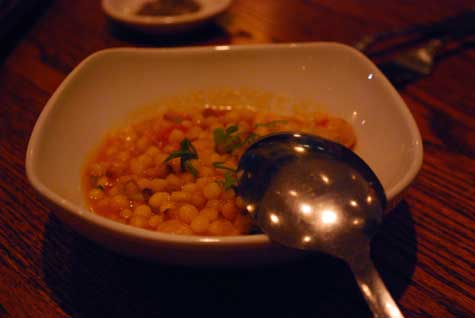 TENDER AND PUNGENT Clams with fregola. |
Since all three of Harding Lee Smith's restaurants are on corners, one wonders why he chose to name his newest one The Corner Room. Maybe the third marks the turning of a corner, a shift in approach? But no, Smith's new restaurant, like his others, lingers at the intersection of avenues leading in quite different directions.
Most fundamentally, The Corner Room sits at the juncture of the inauthentic and the skillful. On the one hand you get no sense that the menu results from a chef's passion for a particular cuisine, the atmosphere seems to be as much about bustle as a good meal, and you sometimes fear your server has forgotten you. But some dishes are done very well, your server pleasantly catches up, and enough of the details are right that you enjoy the meal sufficiently to appreciate its affordability.
And like The Grill Room down the block, the menu at The Corner Room also finds itself at the junction between the expansive and the chaotic. The theme this time is Italian, and there are dozens of antipasti in several categories, plus salads, pizzas, panini, pastas (each in two sizes), and entrées.
While the warm antipasti draw the eye, we had the best experience with the cold ones. Octopus and potato, for example, had more round slices of tender seafood than potato. It was dressed lightly with oil, lemon, cilantro, and crunchy red onion. In the eggplant caponata, often served as a mushy dip, the chunks of eggplant maintained a bit of chew. With the sugar and cocoa in the sauce it took on a figgy flavor and the aroma of clove.
On the warm side, the white bean bruschetta was a bit of a disaster. It has the same problem as the pâté at The Front Room: people would appreciate the generous portion more if the dish were less bland. The white bean spread was puffed up and airy and gave off the sort of heat generated by a microwave. A cod bruschetta was better. It was whipped up with milk and mayo in the New York style, and a bit spongy. The fish could have used more salty cured flavor. We liked tender clams served as a starter with fregola -- tapioca-like balls of pasta -- in a pungent thin and sour wine sauce. The cotechino was also good, especially thanks to a polenta so buttery and creamy it resembled the best kind of grits. It was topped with slices of salty sausage and two eggs with runny yolks. The ricotta and meat in an oxtail crêpe ran together into a rich and satisfying mush.
Pastas were simple and expertly cooked to just the right texture. The right texture meant very tender for the long tubes served with plenty of juicy braised boar. The chef had wisely let the meat hold its own with barely a sauce -- a bit of tomato added to a gravy that was rich and delicious. A simple pesto was deep green, light, fresh and not over-processed. The curly pasta was a perfect al dente.